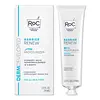What's inside
What's inside
 Key Ingredients
Key Ingredients

 Benefits
Benefits

 Concerns
Concerns

 Ingredients Side-by-side
Ingredients Side-by-side

Water
Skin ConditioningCetearyl Isononanoate
EmollientDicaprylyl Carbonate
EmollientGlycerin
HumectantCetearyl Alcohol
EmollientPropanediol
SolventAscorbyl Glucoside
AntioxidantButyrospermum Parkii Butter
Skin ConditioningHydrogenated Coco-Glycerides
EmollientDimethicone
EmollientGlyceryl Stearate
EmollientPEG-100 Stearate
Cetearyl Glucoside
EmulsifyingButylene Glycol
HumectantCarbomer
Emulsion StabilisingGlyceryl Caprylate
EmollientSodium Hydroxide
BufferingParfum
MaskingXylitylglucoside
HumectantHydroxyacetophenone
AntioxidantSodium Citrate
BufferingAnhydroxylitol
HumectantXanthan Gum
EmulsifyingTocopheryl Acetate
AntioxidantCaprylic/Capric Triglyceride
MaskingXylitol
HumectantDisodium EDTA
Alcohol
AntimicrobialSodium Lactate
BufferingGlucose
HumectantCitric Acid
BufferingHarungana Madagascariensis Extract
Skin ConditioningMarrubium Vulgare Extract
Skin ConditioningCoco-Glucoside
CleansingBalanites Roxburghii Seed Oil
Skin ConditioningPhenethyl Alcohol
MaskingFurcellaria Lumbricalis Extract
Skin ConditioningPancratium Maritimum Extract
BleachingPyrus Sorbus Bud Extract
AstringentUlex Europaeus Leaf/Root/Stem Extract
Skin ConditioningPalmitoyl Tripeptide-1
Skin ConditioningLapsana Communis Flower/Leaf/Stem Extract
Skin ConditioningMaris Sal
Skin ConditioningCI 14700
Cosmetic ColorantPalmitoyl Tetrapeptide-7
Skin ConditioningWater, Cetearyl Isononanoate, Dicaprylyl Carbonate, Glycerin, Cetearyl Alcohol, Propanediol, Ascorbyl Glucoside, Butyrospermum Parkii Butter, Hydrogenated Coco-Glycerides, Dimethicone, Glyceryl Stearate, PEG-100 Stearate, Cetearyl Glucoside, Butylene Glycol, Carbomer, Glyceryl Caprylate, Sodium Hydroxide, Parfum, Xylitylglucoside, Hydroxyacetophenone, Sodium Citrate, Anhydroxylitol, Xanthan Gum, Tocopheryl Acetate, Caprylic/Capric Triglyceride, Xylitol, Disodium EDTA, Alcohol, Sodium Lactate, Glucose, Citric Acid, Harungana Madagascariensis Extract, Marrubium Vulgare Extract, Coco-Glucoside, Balanites Roxburghii Seed Oil, Phenethyl Alcohol, Furcellaria Lumbricalis Extract, Pancratium Maritimum Extract, Pyrus Sorbus Bud Extract, Ulex Europaeus Leaf/Root/Stem Extract, Palmitoyl Tripeptide-1, Lapsana Communis Flower/Leaf/Stem Extract, Maris Sal, CI 14700, Palmitoyl Tetrapeptide-7
Water
Skin ConditioningCaprylic/Capric Triglyceride
MaskingSqualane
EmollientDimethicone
EmollientButylene Glycol
HumectantMethyl Trimethicone
Skin ConditioningGlycerin
HumectantBeta-Sitosterol
Emulsion StabilisingCeramide NP
Skin ConditioningCeramide Ng
Skin ConditioningPalmitoyl Tripeptide-8
Skin ConditioningCamellia Sinensis Leaf Extract
AntimicrobialButyrospermum Parkii Butter
Skin ConditioningEuphorbia Cerifera Wax
Tocopherol
AntioxidantGlyceryl Behenate
EmollientLecithin
EmollientPolyacrylamide
Polysilicone-11
Polyglyceryl-4 Isostearate
EmulsifyingDextran
Oleic Acid
EmollientSodium Acrylates Copolymer
C13-14 Isoparaffin
EmollientAmmonium Acryloyldimethyltaurate/Vp Copolymer
Laureth-7
EmulsifyingPhenoxyethanol
PreservativeEthylhexylglycerin
Skin ConditioningWater, Caprylic/Capric Triglyceride, Squalane, Dimethicone, Butylene Glycol, Methyl Trimethicone, Glycerin, Beta-Sitosterol, Ceramide NP, Ceramide Ng, Palmitoyl Tripeptide-8, Camellia Sinensis Leaf Extract, Butyrospermum Parkii Butter, Euphorbia Cerifera Wax, Tocopherol, Glyceryl Behenate, Lecithin, Polyacrylamide, Polysilicone-11, Polyglyceryl-4 Isostearate, Dextran, Oleic Acid, Sodium Acrylates Copolymer, C13-14 Isoparaffin, Ammonium Acryloyldimethyltaurate/Vp Copolymer, Laureth-7, Phenoxyethanol, Ethylhexylglycerin
 Reviews
Reviews

Ingredients Explained
These ingredients are found in both products.
Ingredients higher up in an ingredient list are typically present in a larger amount.
Butylene Glycol (or BG) is used within cosmetic products for a few different reasons:
Overall, Butylene Glycol is a safe and well-rounded ingredient that works well with other ingredients.
Though this ingredient works well with most skin types, some people with sensitive skin may experience a reaction such as allergic rashes, closed comedones, or itchiness.
Learn more about Butylene GlycolThis ingredient is also known as shea butter. It is an effective skin hydrator and emollient.
Emollients help soothe and soften your skin. It does this by creating a protective film on your skin. This barrier helps trap moisture and keeps your skin hydrated. Emollients may be effective at treating dry or itchy skin.
Shea butter is rich in antioxidants. Antioxidants help fight free-radicals, or molecules that may harm the body. It is also full of fatty acids including stearic acid and linoleic acid. These acids help replenish the skin and keep skin moisturized.
While Shea Butter has an SPF rating of about 3-4, it is not a sunscreen replacement.
Shea butter may not be fungal acne safe. We recommend speaking with a professional if you have any concerns.
Learn more about Butyrospermum Parkii ButterThis ingredient is an emollient, solvent, and texture enhancer. It is considered a skin-softener by helping the skin prevent moisture loss.
It helps thicken a product's formula and makes it easier to spread by dissolving clumping compounds.
Caprylic Triglyceride is made by combining glycerin with coconut oil, forming a clear liquid.
While there is an assumption Caprylic Triglyceride can clog pores due to it being derived from coconut oil, there is no research supporting this.
Learn more about Caprylic/Capric TriglycerideDimethicone is a type of synthetic silicone created from natural materials such as quartz.
What it does:
Dimethicone comes in different viscosities:
Depending on the viscosity, dimethicone has different properties.
Ingredients lists don't always show which type is used, so we recommend reaching out to the brand if you have questions about the viscosity.
This ingredient is unlikely to cause irritation because it does not get absorbed into skin. However, people with silicone allergies should be careful about using this ingredient.
Note: Dimethicone may contribute to pilling. This is because it is not oil or water soluble, so pilling may occur when layered with products. When mixed with heavy oils in a formula, the outcome is also quite greasy.
Learn more about DimethiconeGlycerin is already naturally found in your skin. It helps moisturize and protect your skin.
A study from 2016 found glycerin to be more effective as a humectant than AHAs and hyaluronic acid.
As a humectant, it helps the skin stay hydrated by pulling moisture to your skin. The low molecular weight of glycerin allows it to pull moisture into the deeper layers of your skin.
Hydrated skin improves your skin barrier; Your skin barrier helps protect against irritants and bacteria.
Glycerin has also been found to have antimicrobial and antiviral properties. Due to these properties, glycerin is often used in wound and burn treatments.
In cosmetics, glycerin is usually derived from plants such as soybean or palm. However, it can also be sourced from animals, such as tallow or animal fat.
This ingredient is organic, colorless, odorless, and non-toxic.
Glycerin is the name for this ingredient in American English. British English uses Glycerol/Glycerine.
Learn more about GlycerinWater. It's the most common cosmetic ingredient of all. You'll usually see it at the top of ingredient lists, meaning that it makes up the largest part of the product.
So why is it so popular? Water most often acts as a solvent - this means that it helps dissolve other ingredients into the formulation.
You'll also recognize water as that liquid we all need to stay alive. If you see this, drink a glass of water. Stay hydrated!
Learn more about Water